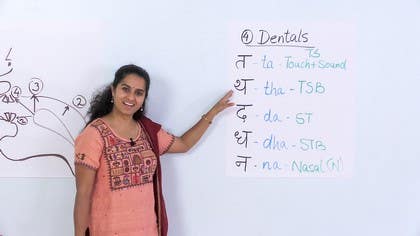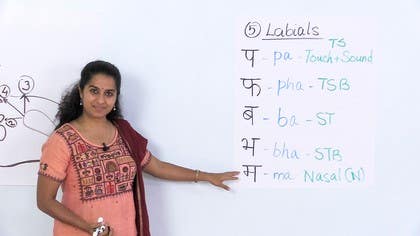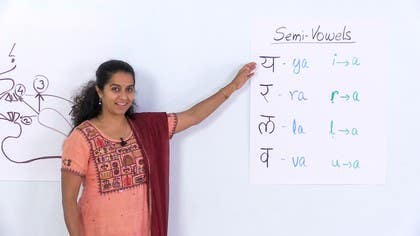Description
About This Video
Transcript
Read Full Transcript
Namaste friends, welcome back. I hope you're enjoying this discovery of the Sanskrit alphabet and the letters as much as I am. So we have been looking at the consonants and been exploring what they sound like. Today we are also going to see what they look like. Thus far we have explored the sounds at the throat or the guttural, followed by the sounds at the palate, the palatal. Next at the roof of your mouth, the cerebrus. We are now going to have a look at the letters corresponding to the teeth or the dentals. This set of sounds again is not part of the English language, the Anglo-Saxon world probably, and it is formed by placing your tongue behind your teeth, behind the top of your teeth, but probably to exaggerate it we could start by sticking the tongue out a little bit and say the there is the first letter has a component of touch and sound so say that the lovely very gentle the first letter is the the then you have the breath on that and then there is the sound and touch so we have the the breath and the nasal now let's combine them with what they look like so this is the series of dentals the first letter that we saw was the the corresponding to a touch and sound the this is slightly different from the cerebral sound where the tongue is rolled in and which is a now listen to the difference this one is the the the it almost softens your heart when you say it and it looks like this so that is the the say that the we will now see what this letter looks like in its transliterated form which is the equivalent in the Roman alphabet of this letter from the Devanagari script this is our good old tea in English but not pronounced as the tea it's pronounced as the the try that very good in terms of the mechanism of the sound it corresponds to touch and then sound touch between us we can use the code TS to indicate touch sound at the teeth the next letter is the same aspect of touch and sound accompanied with your breath so it's a say that we'll now see what it looks like that is the in Roman transliterated form it is one needs to just be careful that one doesn't make it a like in English this is the very good in terms of the sound mechanism it's a touch sound and breath great you're doing fine till here the third letter is a combination of sound and touch at your teeth so it's the the the got that this is what it looks like the yes in English transliteration it is the D and an A but remember again that although you're writing the D the sound is not a hard door it is a soft dental the lovely in terms of the mechanism of the sound it is the sound and then the touch you must be guessing a pattern by now so the next or the fourth letter in this series is the sound touch with your breath it is the D like in my name Anura Dha so we have the Dha there we see what it looks like that's the Dha you will notice that in this series we have two letters where the line doesn't go all the way across and one way you can also remember that is that there is a gap between your teeth so the ones with the breath have the gap the line doesn't go all the way through okay so this is the the in transliteration it is the D H and A and in terms of the mechanism of the sound it's sound touch with your breath so let's say that together Dha once more Dha brilliant the final letter in the series is the nasalized dental sound which is the nna you're more familiar with this one nna nna and it looks like this nna now let's see what it is in transliteration we finally have the plain end with an a it's the nna in terms of the mechanism this letter corresponds to the nasal part of the sound and let's say this together once we have the the the the nna once more the the the the nna now it's your turn perfect a last time we say together the the the the nna super now that we've seen the dentals let's move on in our next section to the last of the series of five letters known as the labials







You need to be a subscriber to post a comment.
Please Log In or Create an Account to start your free trial.